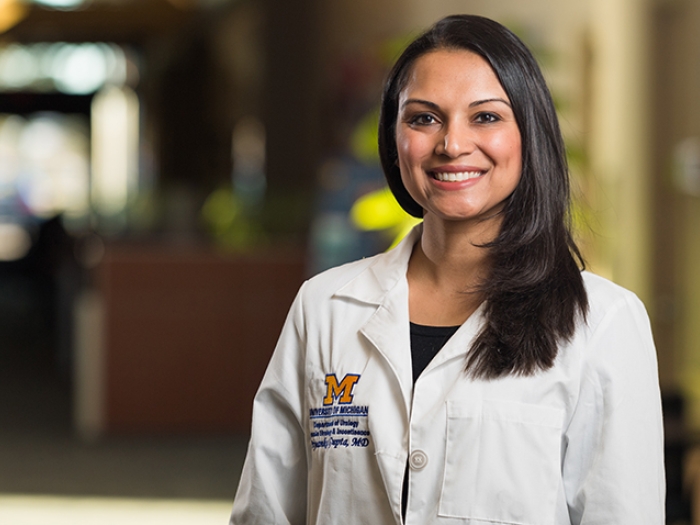Researchers identify new uterine cell types, laying the groundwork for studying challenges like infertility
3:07 PM
Author |

Thanks to billions of cells in a typical uterus, its lining grows and regenerates every month, supporting functions like menstruation and reproduction.
Now, researchers are taking a closer look at the many cell types in the uterus, and how their characteristics and relative numbers change with age and during menstrual cycles.
Findings from a study lay the groundwork for creating a “uterine cell atlas” that may provide insight to the inner workings of a healthy uterus as well as what may contribute to disease.
“The uterus is a complex and dynamic organ whose lining sheds and completely regenerates through every menstrual cycle in a premenopausal person,” said co-senior author Sue Hammoud, Ph.D., associate professor of human genetics, obstetrics and gynecology and urology at the University of Michigan Medical School.
“Understanding the major cell types and cell states that promote its growth and function is important to guiding research on not just the basic biology of the uterus but also disorders and diseases that affect it.”
Using single cell RNA sequencing, Hammoud and colleagues analyzed over 50,000 uterine cells from five healthy premenopausal individuals along with previous data from 15 people.
The Michigan Medicine led findings appear in the journal Proceedings of the National Academy of Sciences of the United States of America.
This is the type of knowledge that may ultimately help us improve outcomes for patients with implantation failure, uterine related infertility and recurrent pregnancy loss.”
-Erica E. Marsh, M.D.
Researchers identified and analyzed multiple, diverse cell types in the uterus, expanding the repertoire of uterine cells that have previously been reported.
This includes progenitor cells, a type of stem cell that can self-renew and differentiate into multiple cell types.
“We identified various types of progenitor cells and saw notable changes of the tissue's makeup over time,” said co-senior author Jun Li, Ph.D., professor of human genetics and professor and associate chair for research of computational medicine and bioinformatics at the U-M Medical School.
“We devoted a lot of our team's efforts on comparing our catalog of diverse cells with past studies, to make sure that cell ontology, or how we classify and describe cells, is harmonized in the field and supported by empirical evidence.”
The uterus has two main layers, or “compartments:” an inner lining called endometrium that nurtures a fertilized egg to become an embryo if pregnancy occurs and a muscular middle layer that provides shape and contraction.
By analyzing tens of thousands of single cells, researchers identified numerous compartment-specific and cross-compartment progenitor cells, as well as cell types showing "dual characteristics."
This suggests that some progenitor cells within one compartment may give rise to cells in another.
By comparing molecular signaling in the human uterus with those reported in the past for mice, the team also found that while some genes may have been lost during evolution, or changed function, the overall outcomes of gene action in the uterus are conserved across mammals.
The study also compared healthy premenopausal tissue samples and those from postpartum and postmenopausal stages, revealing shifts in cellular composition, providing further insight into uterine dynamics over time.
“These findings offer important clues to uterine functions, including the signals sent between cells to allow embryo implantation – potentially helping us predict the time when the uterine lining is most receptive to it,” said co-lead author Nicole Ulrich, M.D., a reproductive endocrinologist and infertility specialist who was a U-M fellow at the time of the study.
The research is part of a project to establish a human cell atlas of the female reproductive system, focusing on the ovaries, fallopian tube, and uterus that was supported by a grant from the Chan Zuckerberg Initiative. The project is led by Hammoud, Li, Marsh, and Ariella Shikanov, Ph.D., professor of biomedical engineering at U-M.
The study follows the team’s previous publications on the fallopian tube and ovaries.
“This study represents team science at its best. This is the type of knowledge that may ultimately help us improve outcomes for patients with implantation failure, uterine related infertility and recurrent pregnancy loss,” said Erica E. Marsh, M.D., professor of obstetrics and gynecology at the U-M Medical School and chief of the division of reproductive endocrinology and infertility at U-M Health Von Voigtlander Women's Hospital.
“This work has major implications for helping us understand not only the pathways for functions like gestation but also what factors may lead to various uterine related diseases, such as adenomyosis, fibroids and uterine cancer.”
Additional authors: Alex Vargo, Qianyi Ma, Yu-chi Shen, Dominic Bazzano, D. Ford Hannum, Stephen Gurczynski, Bethany Moore, Samantha Schon, Richard Lieberman, Ariella Shikanov, all of U-M, and Asgerally Fazleabas, of Michigan State University.
Funding/disclosures: Other funding includes the National Institute of Health (NIH) 1DP2HD091949-645 01 (S.S.H.), T32-GM70449 (D.F.H.), T32- HD079342-10 (D.B), HL144481 (BBM) and Open Philanthropy grant 2019-199327 (5384)
Paper cited: “Cellular heterogeneity and dynamics of the human uterus in healthy premenopausal women,” PNAS. DOI: 10.1073/pnas.2404775121.
Sign up for Health Lab newsletters today. Get medical tips from top experts and learn about new scientific discoveries every week.
Sign up for the Health Lab Podcast. Add us wherever you listen to your favorite shows.

Explore a variety of health care news & stories by visiting the Health Lab home page for more articles.

Department of Communication at Michigan Medicine

Professor
Want top health & research news weekly? Sign up for Health Lab’s newsletters today!





